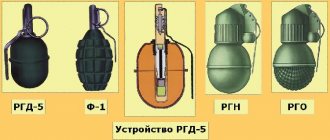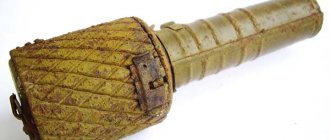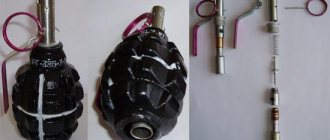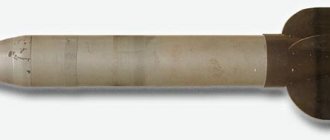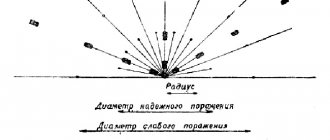The hand grenade is a powerful individual weapon. In the hands of a skilled and well-trained fighter, a grenade is a formidable and effective means of combat. Grenades are jokingly called “pocket artillery,” but there is some truth to this joke. A hand grenade helps a fighter solve approximately the same tasks on the battlefield as artillery: destroy enemy firing points, his manpower and military equipment. At the same time, the hand grenade is distinguished by its simplicity of design, low production cost, light weight and does not require any additional devices for use.
The first hand grenades, similar to modern ones, appeared at the beginning of the 20th century; they were widely used in the Russo-Japanese War, but the high point of “pocket artillery” was the positional trench battles of the First World War.
Anti-personnel hand grenades
Anti-personnel hand grenades are divided into two types: offensive and defensive. In essence, they are similar and the principle of operation is the same, but there are differences, knowing which allows maximum efficiency to be achieved when using hand grenades. Many served in the army, but not everyone had the opportunity to use real, not training grenades, and most only know about them from films. But as you know, in films, entertainment and special effects come first, and no one thinks about realism. Now let’s figure out the differences between offensive grenades and defensive ones.
The main difference is the number and weight of fragments scattered when a grenade explodes. Offensive grenades are lighter and can be thrown over a greater distance. Offensive grenades have a smaller damage radius and smaller fragment weight. This is necessary so that during the attack you do not injure yourself and your comrades with a large number of heavy fragments. Attackers, as a rule, are in worse conditions than defenders, who, as a rule, have shelters, buildings, and trenches at their disposal. Any grenade that hits the target accurately will disable the infantry, but fragments from an offensive grenade will not fly back.
Grenades are defensive, have a larger damage radius, and fragments that are heavier and more dangerous in terms of destructive power. Such grenades are thrown from trenches, buildings, and shelters. The scattering of fragments is greater, the probability of destroying the advancing enemy is greater. And since the one throwing a defensive grenade is in cover, he is not afraid of fragments from his own grenade.
Transportation and storage
Grenades of this type are supplied to military units in wooden boxes. Moreover, they contain separate metal boxes, each of which contains either housings, handles, or fuses. These containers can only be opened with a special knife, which is also included in the kit.
Markings are applied to the lids and walls of wooden boxes using a special compound, from which you can find out the following information:
- how many grenades are inside the container;
- what is their total weight;
- name of grenades, fuses and handles;
- number of the plant where the equipment was manufactured;
- year of manufacture of combat units;
- batch number;
- danger sign.
It is forbidden to unpack those boxes with grenades that are not currently planned to be used. They should be stored in factory-designed boxes.
RGD-5 hand fragmentation grenade
RGD-5 - (hand grenade, remote, GRAU Index - 57-G-717) offensive hand grenade, belongs to the anti-personnel fragmentation hand grenades of the offensive type. This means that it is designed to destroy enemy personnel with hull fragments when it explodes. The grenade reaches its target by throwing it with the hand. Remote action - means that the grenade will explode after a certain time (3.2-4.2 seconds) after it is released, regardless of other conditions. Offensive type - means that the grenade fragments have a small mass and fly at a distance shorter than the possible throw range.
Characteristics of RGD-5
Weight, kg: 0.31 Length, mm: 114 Diameter, mm: 56.8 Explosive: TNT Mass of explosive, kg: 0.11 Detonation mechanism: UZRG, UZRGM, or UZRGM-2 igniter
The burning time of the retarder is 3.2-4.2 seconds.
Externally, the grenade has an oval body made of thin steel. The streamlined body is assembled from an upper and lower part, each of which includes an outer shell and a liner. The igniter hole is closed with a plastic plug during storage. The mass of the grenade with a fuse is 310 g. The explosive charge is TNT weighing 110 grams. The scattering range of fragments is 25 - 30 meters.
The grenade fuse is universal, also suitable for RG-42 and F-1 grenades. Fuse brand: UZRG, UZRGM (from the second half of the 1950s), or UZRGM-2. All these fuses are interchangeable. RGD-5 and the fuse for it. The hole for the fuse in the grenade body is closed with a plastic plug to prevent dirt from getting in.
UZRGM grenade fuse
UZRGM grenade fuse
Application of RGD-5
To use a grenade, you need to straighten the antennae of the safety pin, take the grenade in your right hand (for a right-handed person) so that your fingers press the lever to the body.
Before throwing a grenade, insert the index finger of your left hand into the pin ring and pull out the pin. The grenade can continue to remain in the hand as long as desired, since until the lever is released, the firing pin cannot break the primer.
After choosing the moment of the throw and the target, throw the grenade at the target. At this moment, the lever will rotate under the influence of the striker spring, releasing the striker, and fly off to the side. The drummer will puncture the capsule and after 3.2-4.2 seconds an explosion will occur.
The RGD-5 grenade was adopted for service in 1954, replacing the RG-42 offensive grenade. The experience of World War II showed that the range of RG-42 fragments sometimes exceeded the throwing range, creating a threat of hitting the thrower.
The training and simulation modification of the grenade is called URG-N (training hand grenade - offensive).
RGD-5 fragmentation grenade
RGD5 grenade
Drawing. Fragmentation grenades RGD-5 F-1 RGN RGO
Fragmentation grenades RGD-5 F-1 RGN RGO poster
Notes
- “This happened in Tadmor, where our sappers participated in demining a residential area. When checking an ordinary-looking two-story building, Roman discovered a fishing line at the entrance to the house that led to an RGD-5 grenade prepared for detonation.” Semyonov D.
Palmyra and Aleppo are grateful to them // Red Star. — 2022. — April 19. - A combat grenade is not for a timid soldier // newspaper “For the Glory of the Motherland”, No. 181 of September 27, 2012
- RGD-5 Fragmentation Hand Grenade // North Korea Country Handbook MCIA-2630-NK-016-97. US Department of Defense, May 1997. page A-95
- The SBU vindicated the police who illegally traded armor from the ATO // newspaper “People's Army” dated 14 February 2018
F-1 anti-personnel hand grenade
(GRAU index - 57-G-721)
The F-1 grenade is designed to destroy manpower in defensive combat. Due to the significant radius of scattering of fragments, it can only be thrown from behind cover, from an armored personnel carrier or from a tank.
F-1 fragmentation grenade
F-1 fragmentation grenade
Characteristics of F-1
Diameter, mm 55 Body height, mm 86 Height with fuse, mm 117 Grenade weight, kg 0.6 Explosive weight, kg 0.06-0.09 Explosive type TNT Fuse UZRGM Deceleration time, sec 3.2-4.2 Throw range: 35-40 m Damage radius fragments: 5 m200 m - safe distance
Fuse deceleration time: 3.2-4.2 sec
Number of fragments up to 300 pcs.
The F-1 grenade is a hand-held anti-personnel, long-range defensive fragmentation grenade. Its design turned out to be so successful that it has existed to this day without fundamental changes. The design of the fuse was slightly changed and modified in order to increase operational reliability.
Manual - delivered to the target by throwing the soldier’s hand.
Anti-personnel - designed to destroy enemy personnel.
Fragmentation - damage is caused mainly by fragments of the metal body of the grenade.
Defensive - the radius of scattering of fragments exceeds the average range of throwing a grenade using the muscle strength of a fighter, which necessitates the need to throw a grenade from cover in order to avoid being hit by fragments of one’s own grenade.
Remote action - the grenade detonates some time after the throw (3.2 - 4.2 s).
Application of F-1
To use a grenade, you need to straighten the antennae of the safety pin, take the grenade in your right hand so that your fingers press the lever to the body. Before throwing a grenade, insert the index finger of your left hand into the pin ring and pull it out. The grenade can continue to remain in the hand for as long as desired until the lever is released, the firing pin cannot break the primer (in principle, if the need to throw a grenade has disappeared and the pin has not been thrown out, it can be inserted back (without releasing the lever!); after bending tendrils of pomegranate pins are suitable for normal storage).
Progress does not stand still
After the victory in World War II, the USSR arms complex faced the question of changing weapons.
In order to move forward, it was necessary to reconsider the priority directions for the development of the industry and change the combat units that had been used for a long time. So, instead of the RG-42 grenade, it was necessary to create a more advanced analogue that would cover some of the shortcomings of the existing options. Thus, in 1950, development of a more powerful and efficient unit began. In 1954, the RGD-5 grenade entered service with the military forces of the Soviet Union, the design and characteristics of which were several times higher than those of existing analogues. This combat unit, in its appearance, was vaguely similar to several European models: the French OF, which went into production in 1915, the Polish Z-23 and the German M-39. RGD-5 is a grenade, mostly intended for offensive combat. However, it can also be used to defeat and stunning enemy personnel and during defensive operations (in trenches, in the forest, in populated areas, etc.).
Impact-remote fuse UDZ
UDZ igniter device
The impact-remote fuse UDZ is designed to explode a grenade when it hits an obstacle after being thrown or self-destructing. The fuse has five stages of protection and five functional devices assembled in a sealed polyethylene case (a total of five springs, two igniter caps, two detonator caps): - pin-safety mechanism; - long-range cocking mechanism, designed for 1.0-1. 8 s; - instantaneous impact target sensor; - remote device - self-liquidator for 3.2-4.2 s;
- detonation unit.
Where to wear
Grenades are transported in a wooden box of 20 pieces separately from the fuses. During transportation, instead of a fuse, a plastic or ebonite plug is screwed in to protect the tube from dirt and foreign objects.
The fuses are screwed in immediately before a fight or before a throw.
For individual carrying of grenades, grenade pouches, unloading or special pockets are provided.
Fuses are carried in paper or plastic wrap until used.
RGN offensive hand grenade RGO defensive hand grenade
(GRAU Index – 7G21 and 7G22)
RGN, RGO with UDS fuse, operating principle
To use the RGN or RGO grenade you must:
- screw the fuse into the grenade as far as it will go and take it in your hand so that the lever is pressed with your fingers to the grenade body; - straighten the ends of the pin (1st stage of protection);
- pull the pin by the ring (2nd stage) and throw the grenade at the target.
When throwing a grenade, the lever (3rd stage) is separated and the firing pin, turning on an axis, pierces the primer - the igniter in the side socket of the fuse body. The fire ignites the pyrotechnic compositions of two pushers and a self-liquidator. As the pyrotechnic compositions burn out, the pushers are lowered in the cups under the action of springs, releasing the engine, which moves to the center under the action of its spring, installing the primer - the igniter under the sting of the target sensor (4th stage) - now the fuse is ready for action.
During an impact with an obstacle, the spherical weight, shifting, squeezes out the target sensor sleeve, which, overcoming the resistance of the spring (5th stage), punctures the primer with its sting - the igniter of the engine. Ignition causes an explosion of the primer - the detonation unit and the explosive charge. If the impact of a grenade on an obstacle for some reason does not cause an explosion, then 3.2-4.2 seconds after the igniter capsule is punctured, the pyrotechnic composition of the remote mechanism finishes burning, causing the detonator capsule to operate and self-destruct.
Characteristics of RGNWeight, kg: 290 gLength, mm: 113 mmDiameter, mm: 60 mmExplosive: A-IX-1 (96% hexogen, 4% wax) (plastic)Weight of explosive, g: 97 g
Detonation mechanism: UDS igniter with deceleration time 3.3-4.3 s
Characteristics of RGOWeight, kg: 530 gLength, mm: 113 mmDiameter, mm: 61 mmExplosive mass, g: 92 g
Detonation mechanism: UDS ignition with a deceleration time of 3.3-4.3 seconds.
All grenades are available in several versions. Combat grenades are painted olive green, training grenades are painted black.
European modification
In the army of the Soviet Union, the RGD-5 grenade, a photo of which can be seen in this article, was adopted for service in 1954. Then, after the collapse of the great power, many CIS countries retained this combat unit in their equipment. In addition, the RGD-5 grenade is used in many foreign countries: China, India, Korea, etc. It is noteworthy that the production of this type of weapon was carried out on the territory of Bulgaria and Poland. Twenty years after the release of the first grenade, it was the scientists of these countries who proposed replacing the fuse on the grenade. As a result, RGD-5 received a new fuse called DVM-78, a larger mass - 450 grams and a new name - RGO-78.
The principle of lethality
Fragments from a torn RGD-5 grenade
At the fuse of the grenade, there is a pin, which at the end branches out with tendrils and is secured in such a way as to prevent an arbitrary explosion. Before throwing, you need to straighten the antennae and pull the pin with some force.
The installed pin secures the safety lever and after its removal, the safety remains in the blocking position due to the hand of the grenade thrower. After releasing it, there are 3-4 seconds left to throw and cover from fragments.
After removing the safety lever, the impact mechanism is triggered and thereby hits the primer, which in turn ignites. Due to the delay mechanism, the thrower is given a few seconds to throw.
The kinetic energy of the impact ignites the powder retarder charge. He lights the detonator cap. The detonator detonates the main TNT charge. The released energy tears the body into a hundred fragments and creates a shock wave. The radius of destruction of the RGD-5 grenade is 25 meters.
Description and characteristics
The RGD 33 grenade had the following device. It consisted of a body that contained an explosive (most often it was TNT, but other types of explosives were also used during the war), a handle with a striker and a spring, and a detonator fuse, which was inserted into the grenade body on the other side. The detonator socket was closed with a special flap (sliding or rotating); a special washer was installed between the grenade handle and the body, which securely fixed the handle and prevented it from unscrewing. The RGD 33 grenade without a defensive casing weighed 495 grams, its length with a handle was 191 mm, and its body diameter was 52 mm.
The grenade was delivered to the troops completely disassembled. The body, handle and fuse came separately. Before the battle, the fighters screwed the handle to the body, after which it was no longer possible to disassemble the grenade. Grenades were carried in special bags, and the fuses were kept separately in them. Immediately before use, a fuse was inserted into the socket, and the grenade was put on safety. It was also necessary to cock the spring in the handle. Before throwing a grenade, it was necessary to remove the safety catch and throw it at the target. Due to the energy of the throw, the striker punctured the detonator capsule and an explosion occurred. The explosion occurred with a slowdown of 3.5-4 seconds. A trained fighter could throw an RGD 33 grenade at 35-40 meters.
